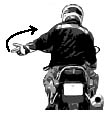Seventeen tips to ensure everybody has a great day - Friday, May 16, 2003 at 09:10 
|
By Bill Andrews (Apr. 23)
The engine purrs beneath you as a string of motorcycles snakes through the hills in front of you. With a quick look in the mirror, you see your buddy following close behind with a smile on his face that matches yours. The camaraderie forms because, at just this moment, you're all on the same page.
That's what a group ride is all about. It's an opportunity to share the open road and wonderful scenery with other like-minded people.
But like most motorcycle experiences, this one is best enjoyed by following a few simple guidelines that keep everyone safe. And that's the idea behind a new videotape put out by the Motorcycle Safety Foundation that focuses on group riding. You can get your own copy by visiting the MSF website at: www.msf-usa.org, but here's a few tips from the country's foremost motorcycle safety experts.
1) The first thing you want to do is organize the ride. This can be as informal as standing around in a parking lot, or as complicated as a special meeting to hand out maps and cellphone numbers.
2) Remember that riding in a group does not mean you surrender any decision making when it comes to your safety. Ride your own ride, and don't go any faster than you feel comfortable going.
3) When picking your route and the stops you'll make along it, consider the stamina of the group, the experience of all the riders, and the limits of the motorcycles in the group. Remember, these are your friends. If it's going to be a long ride, be sure to have a few break stops along the way.

Click here to see some commonly used hand signals.
4) You'll need to communicate while on the ride, so make sure everyone knows the signals you'll use.
5) When creating your formation, it's wise to have your experienced riders at the lead and running sweep. Consider positioning the less experienced riders immediately behind the leader. This allows the front rider to adjust the pace if necessary.
6) Ideally, the sweep rider will have a cellphone to call for help if a motorcycle is disabled, or if there has been an accident.
7) If the goal of the ride is to keep the group together, the leader should only go at the pace of the least experienced rider.
8) While riding, don't fixate on the motorcycle in front of you. Instead, remember your basic training. Look well through the turn to where you want to go.
9) If the group is riding faster than you are comfortable with, let the sweep rider know you're dropping out and ride at your own pace. So you may reach your destination a few seconds behind the others, but you will get there, and that's what's important. Keep in mind, it's all about fun.
10) All riders are also responsible for making sure their motorcycles are mechanically up to the task. Before you even meet up with the group, make sure you've got plenty of fuel in the tank, and you've taken care of all those maintenance issues. Not sure what to check? Use T-CLOCK. You really don't want to be the reason for stopping the group for something mechanical you could have prevented.
11) If it's going to be a large group, consider establishing a buddy system among the riders, or divide the group into smaller five- or seven-rider packs. That way, if something goes wrong, you don't have 25 motorcycles sitting on the side of a busy highway. Also, smaller groups can more easily navigate through city streets.
12) On the road, motorcyclists should have at least a 2-second cushion in front and behind them. If you want to keep the group tight, consider a staggered formation. Leave enough room per lane so each rider can maneuver side-to-side if need be. Avoid side-by-side formations as they shrink your space cushion.
13) Trikes and sidecars should stay in the center of the lane, and should be given the same amount of cushion as if they were a car.
14) As turns get sharper, or as visibility decreases, move back to a single file formation. You'll also want to use single file when entering or exiting a highway, at toll booths, or when roads have a rough or questionable surface.
15) At intersections where you've come to a stop, tighten the formation to side-by-side to take up less space. As the light turns green, or when traffic opens up, the bike on the left proceeds through first.
16) Remember we share the road with many other vehicles, and it's against the law to block an intersection.
17) When parking, try to get the group off the roadway as quickly as possible. If you can, arrange in advance to have pull-through parking at your destination, or at the very least, make sure there is ample parking for your size group.
Want more group-riding tips for your club or group? Order the MSF Guide to Group Riding video at www.msf-usa.org, cost is $15.00 for a video and a handbook.
© 2003, American Motorcyclist Association
|
|
|
|

